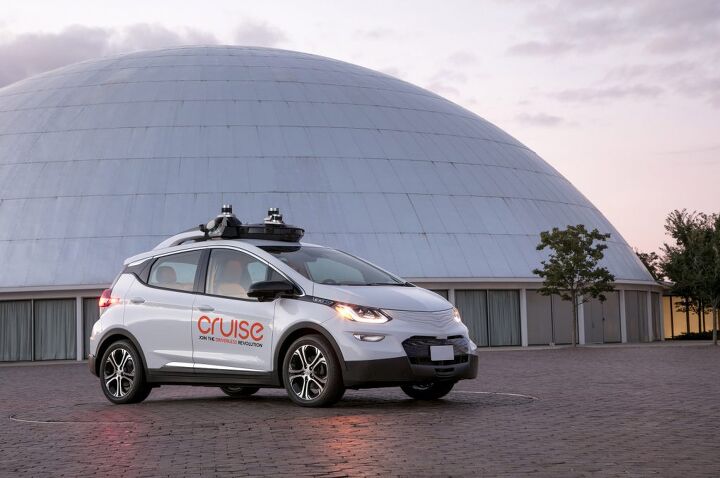Honda Invests Big in GM's Cruise Self-driving Arm

Honda likes what GM Cruise LLC is doing, and wants it to have some cash. On Wednesday, the Japanese automaker announced it would invest $2.75 billion in the GM-owned autonomous driving company, hoping to reap some of the reward of its purpose-built self-driving car.
While still under development, Cruise claims the vehicle — free of such things as a steering wheel or pedals — will arrive in 2019. Already, the company has a fleet of modified Chevrolet Bolts operating as testbeds for the technology. Once unveiled, GM Cruise plans to use the vehicle in a new ride-hailing service while also making it available to others, potentially funneling big bucks into its parents’ coffers. Honda’s, too.
Honda’s investment sees the automaker hand over $750 million up front, with the rest of the sum changing hands over the course of 12 years. The $2 billion will go towards development and mass production of the vehicle.
In a joint statement, the automakers said the investment will aid in the creation of a vehicle “that can serve a wide variety of use cases and be manufactured at high volume for global deployment.” For its contribution, Honda nets a 5.7 percent stake in GM Cruise LLC, which now carries a valuation of $14.6 billion.
The two automakers also announced they “will explore global opportunities for commercial deployment of the Cruise network.”
Alternative revenue streams are what Cruise is all about. The automaker purchased the Silicon Valley startup in 2016 for $581 million, tasking it with the development of GM’s own self-driving car. The unit purchased LIDAR maker Strobe a year later. Earlier in 2018, Cruise’s fortunes rose after a $2.25 billion investment from the Softbank Vision Fund — an investment that garnered the firm a 19.6 percent stake.
“The Honda partnership paves the way for massive scale by bringing a beautiful, efficient, and purpose-built vehicle to our network of shared autonomous vehicles,” said Cruise CEO Kyle Vogt in a statement.
As for the vehicle under development, progress is apparently well advanced. In a statement reported by Automotive News, GM president Dan Ammann, who oversees Cruise, said the car is the first purpose-built production vehicle that is “free from the constraints of having to think about vehicle design and having a driver at the wheel, and all the traditional approaches to that.”
Forgive this writer for feeling a little concerned about his driving future.
[Images: General Motors]

More by Steph Willems
Latest Car Reviews
Read moreLatest Product Reviews
Read moreRecent Comments
- Probert They already have hybrids, but these won't ever be them as they are built on the modular E-GMP skateboard.
- Justin You guys still looking for that sportbak? I just saw one on the Facebook marketplace in Arizona
- 28-Cars-Later I cannot remember what happens now, but there are whiteblocks in this period which develop a "tick" like sound which indicates they are toast (maybe head gasket?). Ten or so years ago I looked at an '03 or '04 S60 (I forget why) and I brought my Volvo indy along to tell me if it was worth my time - it ticked and that's when I learned this. This XC90 is probably worth about $300 as it sits, not kidding, and it will cost you conservatively $2500 for an engine swap (all the ones I see on car-part.com have north of 130K miles starting at $1,100 and that's not including freight to a shop, shop labor, other internals to do such as timing belt while engine out etc).
- 28-Cars-Later Ford reported it lost $132,000 for each of its 10,000 electric vehicles sold in the first quarter of 2024, according to CNN. The sales were down 20 percent from the first quarter of 2023 and would “drag down earnings for the company overall.”The losses include “hundreds of millions being spent on research and development of the next generation of EVs for Ford. Those investments are years away from paying off.” [if they ever are recouped] Ford is the only major carmaker breaking out EV numbers by themselves. But other marques likely suffer similar losses. https://www.zerohedge.com/political/fords-120000-loss-vehicle-shows-california-ev-goals-are-impossible Given these facts, how did Tesla ever produce anything in volume let alone profit?
- AZFelix Let's forego all of this dilly-dallying with autonomous cars and cut right to the chase and the only real solution.


































Comments
Join the conversation
I will NEVER EVER ride in an autonomous vehicle that does not have redundant controls. NEVER EVER.
I'm with mjz. There is no upside to removing the physical controls. The way I see it there are only two plausible reasons for that design change, and they are pr shock value and cost savings. Neither, obviously, is sufficient justification to remove the most important failsafe a self driving car could have, the squishy grey computer that has been handling this kind of math with ease for decades. I won't get in one and I will have an angry response to seeing them on the street. It makes me think poorly of GM and Honda that they would participate in a program or business model set up this way.